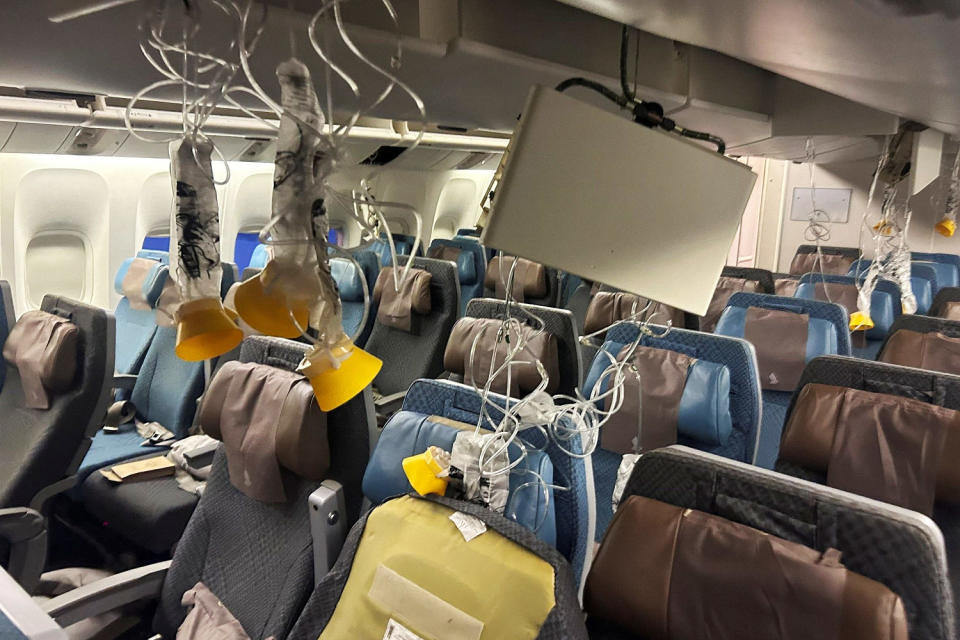One passenger died and 30 others were injured aboard a Singapore Airlines flight that was hit by “severe turbulence,” officials said Tuesday, but experts say such deaths are rare even as researchers warn climate change could trigger more extreme cases of turbulence .
Since 2009, the National Transportation Safety Board said, there have been no U.S. fatalities due to turbulence aboard large commercial aircraft, such as the Boeing jet that experienced sudden extreme turbulence over Myanmar’s Irrawaddy River at 11,000 meters height.
A 73-year-old passenger who had medical problems died, possibly from cardiac arrest, and at least seven people were seriously injured, Kittipong Kittikachorn, general manager of Bangkok’s Suvarnabhumi Airport, said at a news conference on Tuesday.

The cause of the turbulence is being investigated. Singapore Airlines said the flight from London to Singapore encountered severe turbulence about 10 hours after departure.
Death from turbulence is rare, but serious encounters are not uncommon, according to Larry Cornman, a physicist and project scientist at the U.S. National Science Foundation National Center for Atmospheric Research.
“A lot of times it’s just the wrong place and the wrong time for something like this,” said Cornman, who studies small-scale movements of the atmosphere that can endanger aircraft.
Out of millions of flights, turbulence caused 185 serious injuries between 2009 and 2023, the last year of publicly available data, according to the National Transportation Safety Board.
The agency, which requires airlines to report injuries and deaths, categorizes serious injuries as those requiring more than two days of hospitalization; includes every internal organ; or results in broken bones, second- or third-degree burns, severe bleeding, or damage to nerves, muscles, or tendons.
Of the reported incidents between 2009 and 2022, at least 129 crew members and 34 passengers were injured.
Deaths from turbulence can be caused by heart attacks or head injuries if a passenger’s head hits the ceiling or is struck by falling luggage, Cornman said.
“Anything that can cause a death on the ground can certainly cause a death in an aluminum tube at 35,000 feet,” he said, adding that seatbelted passengers should still feel safe in the air.
“These large transport aircraft are built quite strongly. They won’t break up or come out of the air due to turbulence,” Cornman said.
Sara Nelson, president of the Association of Flight Attendants-CWA, said initial reports appear to indicate the flight in Singapore encountered open-air turbulence – the most dangerous type because it is not visible and virtually undetectable with current technology.
“One second, you’re sailing smoothly,” Nelson said. “The next moment, passengers, crew and unsecured carts or other items are thrown throughout the cabin.”
Nelson and a group of researchers say such incidents of open-air turbulence — which are difficult to predict and avoid because it is not associated with storms — are increasing due to climate change.
A 2023 study published in the journal Geophysical Research Letters found that severe clear-air turbulence increased by more than 50% over the North Atlantic Ocean between 1979 and 2020.
The increase in turbulence is likely due to the effect of climate change on wind speeds in the upper levels of the atmosphere, the researchers found. Some of the most pronounced increases in clear-air turbulence in recent decades occurred in mid-latitude regions, including over the North Atlantic Ocean and flight paths over the United States, according to the study.
The results suggest that global warming may be causing instability in the jet stream, a conveyor belt of fast-moving air that encircles the Earth above the Northern Hemisphere, said Mark Prosser, co-author of the study and doctoral researcher at the University of New York. Reading in Britain.
The jet stream, which flows like a river of air from west to east, is fueled by temperature differences between cooler regions in the north and warmer air masses in the south. Climate change could throw the jet stream out of balance, which could have huge consequences for future air travel, Prosser said.
“Airplanes like to fly with the jet stream,” he said, “but where airplanes like to fly is ironically where all the turbulence is.”
That instability is expected to increase as the world warms. Prosser’s colleagues at the University of Reading separately used climate models to predict how clear-sky turbulence could shift in the second half of this century if global warming continues. The researchers found that increasing greenhouse gas emissions also increased turbulence and instability.
“If you compare the climate from 2050 to 2080 with the climate before we started emitting greenhouse gases – so in pre-industrial times – there was a doubling or sometimes even a tripling of the amount of turbulence in the clear air in the atmosphere,” Prosser said.
A total of 211 passengers and 18 crew were on board the Singapore Airlines flight when it shook in mid-air, the airline said in a statement. According to flight tracking site FlightAware, the plane suddenly fell from 37,000 feet to 31,000 feet within five minutes.
The pilot declared a medical emergency and diverted the plane to Thailand’s capital Bangkok, where it landed at 3:45 p.m. local time (4:45 a.m. ET), the airline said.
Officials did not release the identity of the deceased passenger on Tuesday.
The people on the flight were mainly from Australia, Britain, Singapore and New Zealand, the airline said. Four passengers came from the United States.
“Singapore Airlines extends its deepest condolences to the family of the deceased,” the statement said. “We deeply apologize for the traumatic experience our passengers and crew suffered during this flight.”
This article was originally published on NBCNews.com